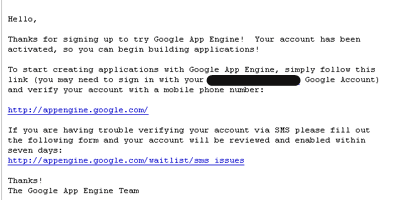 Google seems to love and hate me at the same time. Some moments ago (I forgot the date I filled the application), I submitted application form for testing its App Engine. I was just curious about its cloud computing environment and wondered if the infrastructure they built could properly address some issues common in grid computing or cloud computing architecture. Also, I thought it would also be nice for me, although I’m not exposed to the details of the architectural implementation, to use their infrastructure for research purpose as I’m currently researching on distributed systems.
Google seems to love and hate me at the same time. Some moments ago (I forgot the date I filled the application), I submitted application form for testing its App Engine. I was just curious about its cloud computing environment and wondered if the infrastructure they built could properly address some issues common in grid computing or cloud computing architecture. Also, I thought it would also be nice for me, although I’m not exposed to the details of the architectural implementation, to use their infrastructure for research purpose as I’m currently researching on distributed systems.

I received an email from Google containing the approval of my application. No need to explicitly express how radiant I was to receive such notification because it really means something, to be frank. The caveat is, current SDK provided only supports Python programming language, a language I am not so familiar with. I have never spent hefty amount of dedicated time learning Python, to get to know what’s inside and out. Lacking the knowledge can be a taxing obstacle, but let’s just see if I am up to the challenge.
Later, I will provide an article about cloud computing for those who want to know why it’s often said as a promising architecture for future web computation.
In the meantime, if you have ideas about applications to build or good references for Python, just let me know. The comment section is open 😉




